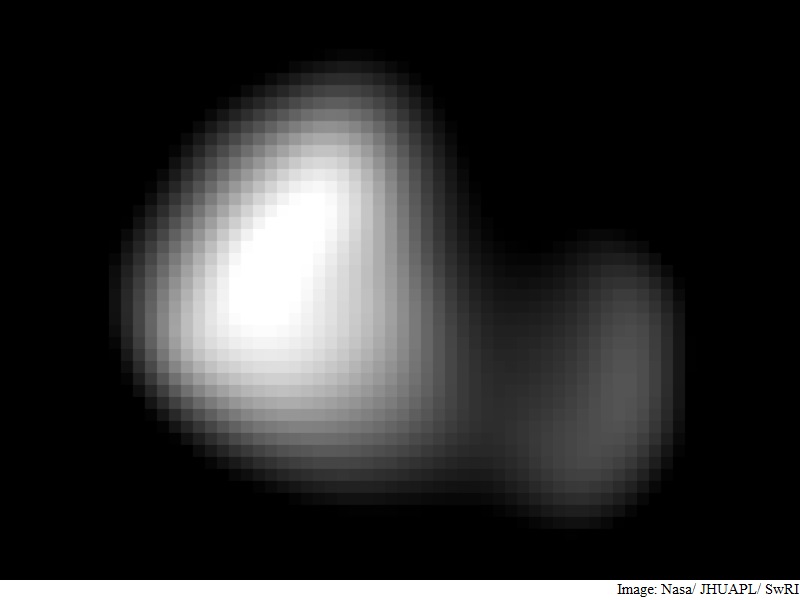- Home
- Science
- Science News
- Nasa's New Horizons Probe Reveals Last of Pluto's Moons
Nasa's New Horizons Probe Reveals Last of Pluto's Moons

Kerberos appears to have a double-lobed shape, around 12 km in its long dimension and 4.5 km in its shortest dimension, US space agency Nasa said in a statement.
"Once again, the Pluto system has surprised us," said New Horizons project scientist Hal Weaver, of the Johns Hopkins University's Applied Physics Laboratory in Laurel, Maryland.
An image of Kerberos was created by combining four Long Range Reconnaissance Imager (LORRI) pictures taken on July 14. The new data was downlinked from the New Horizons spacecraft on October 20.
Scientists speculate from its unusual shape that Kerberos could have been formed by the merger of two smaller objects.
The reflectivity of Kerberos' surface is similar to that of Pluto's other small moons (approximately 50 percent) and strongly suggests Kerberos, like the others, is coated with relatively clean water ice.
Earlier, scientists theorised Kerberos was relatively large and massive, appearing faint only because its surface was covered in dark material.
But the small, bright-surfaced Kerberos now revealed in new images shows that the idea was incorrect, for reasons that are not yet understood.
"Our predictions were nearly spot-on for other small moons, but not for Kerberos," said New Horizons co-investigator Mark Showalter, of the SETI Institute in Mountain View, California.
The new results are expected to lead to a better understanding of Pluto's fascinating satellite system.
The images of Kerberos taken by Nasa's New Horizons spacecraft complete the family portrait of Pluto's moons - Styx, Nix, Kerberos, Hydra and Charon.
For the latest tech news and reviews, follow Gadgets 360 on X, Facebook, WhatsApp, Threads and Google News. For the latest videos on gadgets and tech, subscribe to our YouTube channel. If you want to know everything about top influencers, follow our in-house Who'sThat360 on Instagram and YouTube.
Related Stories
- Samsung Galaxy Unpacked 2025
- ChatGPT
- Redmi Note 14 Pro+
- iPhone 16
- Apple Vision Pro
- Oneplus 12
- OnePlus Nord CE 3 Lite 5G
- iPhone 13
- Xiaomi 14 Pro
- Oppo Find N3
- Tecno Spark Go (2023)
- Realme V30
- Best Phones Under 25000
- Samsung Galaxy S24 Series
- Cryptocurrency
- iQoo 12
- Samsung Galaxy S24 Ultra
- Giottus
- Samsung Galaxy Z Flip 5
- Apple 'Scary Fast'
- Housefull 5
- GoPro Hero 12 Black Review
- Invincible Season 2
- JioGlass
- HD Ready TV
- Laptop Under 50000
- Smartwatch Under 10000
- Latest Mobile Phones
- Compare Phones
- Redmi Turbo 4
- Vivo Y200+
- Lava Yuva 2 5G
- OnePlus Ace 5
- OnePlus Ace 5 Pro
- Oppo A5 Pro 5G
- Vivo Y29 5G
- Honor Magic 7 RSR Porsche Design
- Asus Zenbook S 14
- MacBook Pro 16-inch (M4 Max, 2024)
- Honor Pad X9 Pro
- Honor Pad V9
- boAt Enigma Gem
- boAt Enigma Daze
- Sony 65 Inches Ultra HD (4K) LED Smart TV (KD-65X74L)
- TCL 55 Inches Ultra HD (4K) LED Smart TV (55C61B)
- Sony PlayStation 5 Pro
- Sony PlayStation 5 Slim Digital Edition
- Blue Star 1.5 Ton 3 Star Inverter Split AC (IC318DNUHC)
- Blue Star 1.5 Ton 3 Star Inverter Split AC (IA318VKU)

















